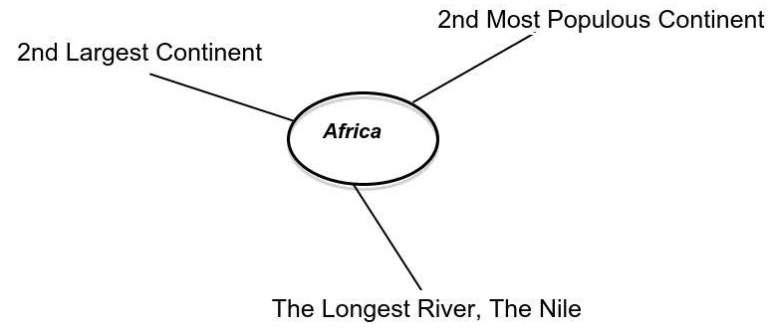Lesson 1 – Objectives
- Reading Comprehension
- Listening Comprehension
- Viewing Comprehension
- Vocabulary Development
- Literature
- Writing and Composition
- Oral Language and Fluency
- Grammar Awareness
Lesson 1: Beginning the Knowledge Quest
- Adjust reading rate based on one’s purpose for reading and the reading material.
- Identify stress, intonation, and pause as elements of spoken language that serve as carriers of meaning.
- Organize information from what has been viewed.
- Use different strategies for coping with unfamiliar words and ideas.
- Discover literature as a means of understanding the human being and the force/s he has to contend with.
- Accomplish forms and prepare notices.
- Use appropriate stress, intonation, and pausing to suit the message and audience.
- Use varied adjective complementation.
Activity 1: WHAT DO YOU KNOW?
Use the semantic web below to indicate what you know about Africa. You may use a word or a phrase.

Activity 2: Reading
Read: http://www.theshortform.com/story/the-hands-of-the-blacks
Activity 3: HOW?
- Read again the story “The Hands of the Blacks”.
- Do the following:
a. Write down all the unfamiliar/difficult words you encounter.
b. Find a way to learn what each unfamiliar/difficult word means.
Use the given table on the next page to summarize your work.

Activity 4: Topic
STRATEGIES TO HELP IMPROVE VOCABULARY
- Context Clues
Learning the meaning of words from the context of your reading material can be
the most useful strategy to increase your vocabulary comprehension. Using the
context that surrounds an unknown word helps to reveal its meaning.
2. Word Structure
Sometimes a word can give clues to the meaning in its structure. Analyzing the
word’s structure and properties is a vocabulary strategy that you can use to figure
out the word’s meaning. When you approach an unknown word, you can guess at
its meaning by breaking down the parts of the word.
3. Visual-Aural Association
When you use visual-aural association, you think of a word that either looks like
or sounds like the word whose meaning you are trying to learn. Thinking of the
picture of the look-alike word and/or image will help you remember the word and
its meaning.
4. Dictionary
The best way to improve your vocabulary is to carry a pocket dictionary to look
up new words as you encounter them. Or, you can collect a list of new words you
encounter to look up at the end of the day.
Activity 5: PROCESS QUESTIONS
- Who answered why the black’s hands are lighter than the rest of their bodies?
Father Christiano, Dona Dores
2. Why do you think each of them gave such an explanation?
They gave such an explanation because they want to make everyone equal.
Activity 6: WHAT IS COMMON?
Take note of the bold words and the underlined groups of words in the following sentences.
- What is common among the words in bold font?
They are all emotions.
2. What is common among the underlined words?
They are answers to the words in bold front.
Activity 7: Reading
Read: https://www.poemhunter.com/poem/african-child-3/
Activity 8: Topic
Basic Elements of Spoken Language
Stress, intonation, and pause are basic elements of spoken language that serve as carriers of meaning. They may aid or interfere in the delivery of the message.
Stress is the emphasis placed on a sound, syllable, or word by saying it relatively more loudly and forcefully.
Intonation refers to the way the pitch of a speaker’s voice rises or falls.
Pause is a break, temporary stop, or rest in speaking (or reading) to emphasize or clarify meaning.
Activity 9: Reading
Read: https://www.slideshare.net/dominae24/what-is-educated-filipino-by-francisco-benitez
Activity 10: Reflect and Understand
Identify the similarities and differences of the two selections in terms of the following:
- State of the nation then.
Philippines, Africa
2. State of the nation now.
Philippines, Africa
3. Concept of education.
They want to have a better education. Giving children a better life in school.
Activity 11: GRAMMAR TOPICS ADJECTIVES AND TYPES OF ADJECTIVES
An adjective is defined as a word used to modify a noun or pronoun. It limits or qualifies nouns or pronouns by telling what kind, which one, how many or how much. Adjectives allow writers to describe color, tastes, shapes, sizes, and a multitude of other qualities; they can add important details to a sentence. Let us start by doing this activity. Encircle the correct picture that matches the given descriptive word in each item below.

